Outforia Quicktake: Key Takeaways
- Bear spray is designed to deter aggressive bears, while pepper spray is for personal defense against humans.
- Bear spray has a longer range and higher concentration of active ingredients than pepper spray.
- Both sprays use oleoresin capsicum as the active ingredient, but the amount differs between the two.
- Bear spray is regulated by the US Environmental Protection Agency (EPA), while pepper spray is not.
- It is not recommended to use pepper spray as an alternative to bear spray or vice versa, as they are designed for specific situations and may not be effective in other scenarios.
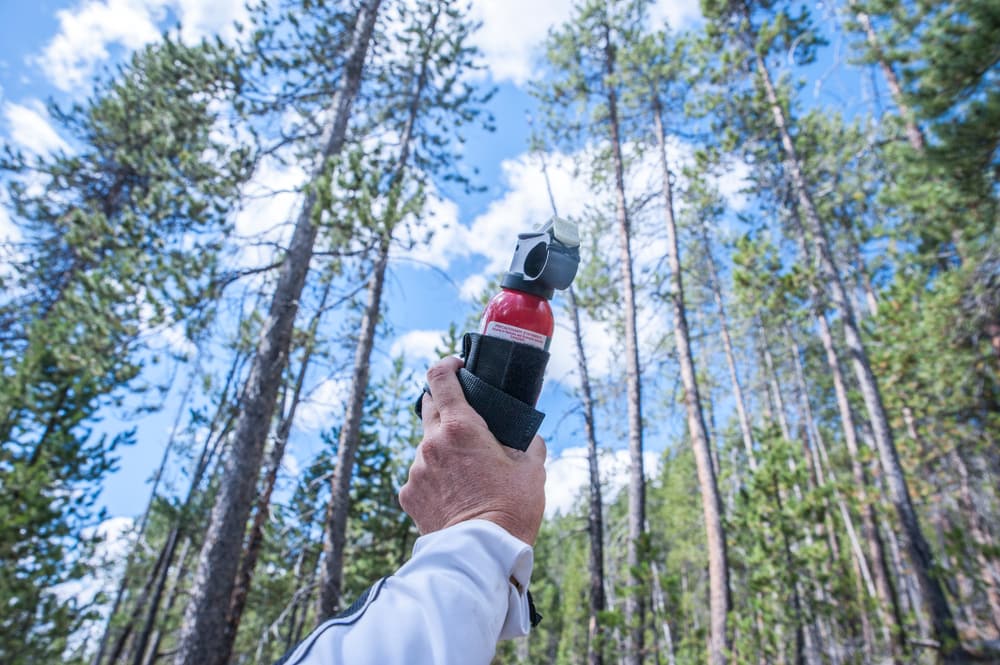
Thousands of people encounter bears each year. Most bear encounters don’t result in an attack. However, people traveling in the great outdoors should be aware of bears.
It’s recommended to bring bear spray along on outdoor excursions just in case you encounter an aggressive bear that decides to charge you. Pepper spray is used as a personal defense tool. It can allow users to get away from assailants trying to cause them physical harm.
In this article, we will discuss the differences between bear spray vs. pepper spray. We’ll also discuss how effective each of these sprays is and their intended uses.
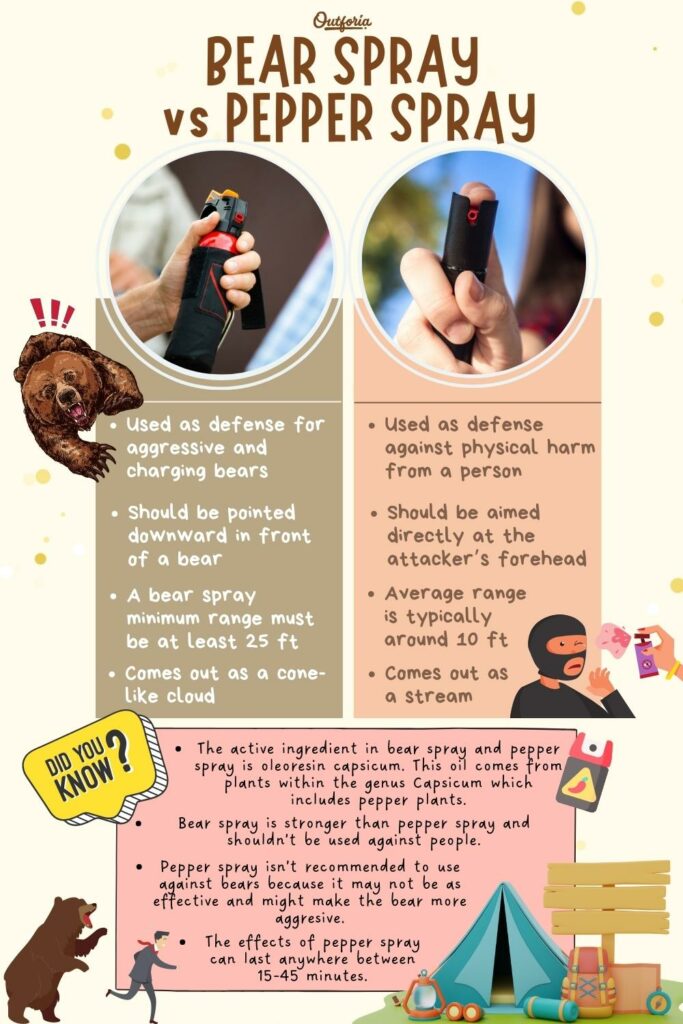
SHARE THIS IMAGE ON YOUR SITE
<a href="https://outforia.com/bear-spray-vs-pepper-spray/"><img style="width:100%;" src="https://outforia.com/wp-content/uploads/2022/12/bear-spray-vs-pepper-spray-infographics-683x1024.jpg"></a><br>BEAR SPRAY VS PEPPER SPRAY <a href="https://outforia.com">Outforia</a>What is Bear Spray?
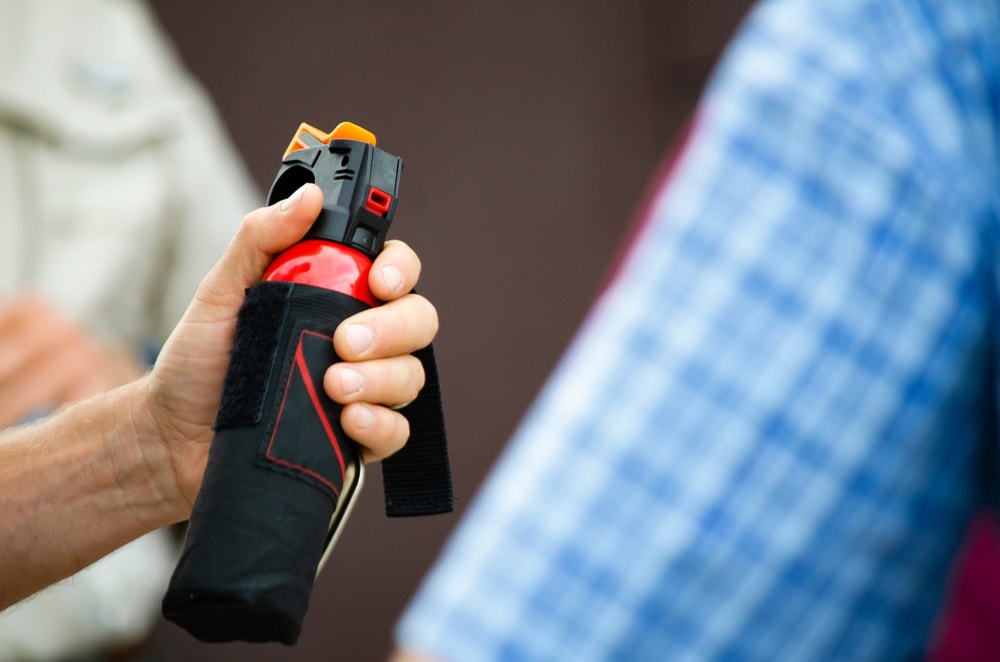
Bear spray is a type of oil-based deterrent used to stop an aggressive bear that’s charging. It is pressurized in an aerosol can. It can be used as a tool to allow individuals to get away in the event of a potential bear attack.
If you’re hiking, camping, or taking part in other outdoor activities, bear spray is recommended to keep on hand. When bear spray is deployed, it spurts out a wall of spray that has inflammatory effects on the bear.
Bear spray should be kept accessible by the user at all times while in nature, especially in areas known to have bears.
American black bears (Ursus americanus) are the most common type of bear species in North America. Black bears aren’t considered a high threat to humans because of their relatively calm demeanor.
Most black bears that enter highly populated areas or campsites are searching for food. Some black bears may be curious and want to investigate. However, most black bears get spooked when encountering humans and don’t mean any harm.
Grizzly bears (Ursus arctos horribilis) are more common in the US and Alaska’s northwestern states and western territories in Canada. Other types of brown bears (Ursus arctos) can be found in many parts of Europe. Grizzly bears are more aggressive than black bears.
The Purpose of Bear Spray
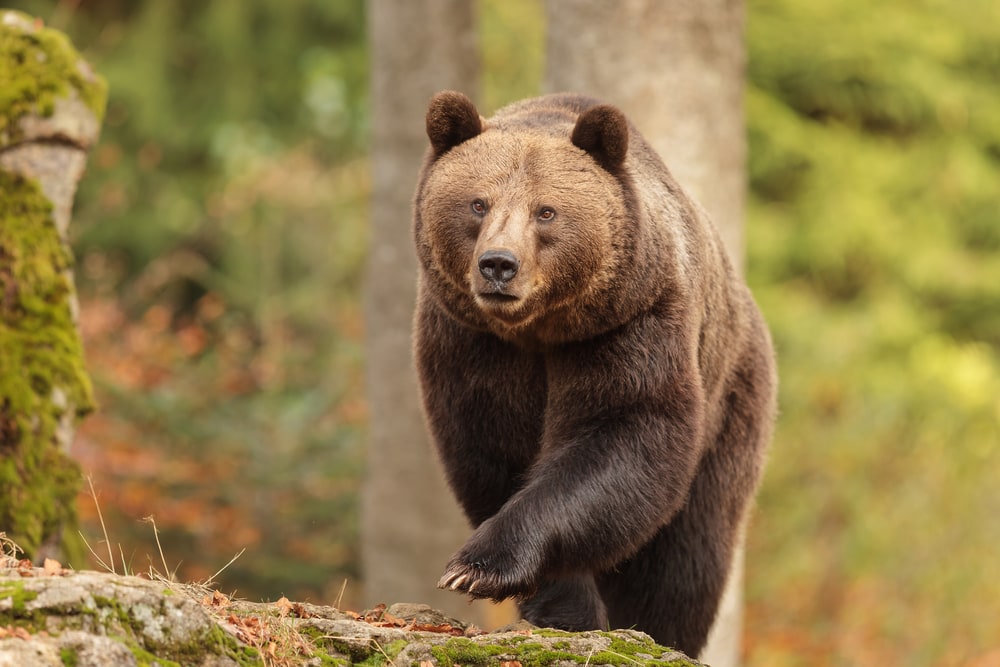
Bear spray is used to deter bears from charging and attacking you. It shouldn’t be used on people or bears that aren’t aggressively charging.
Deploying bear spray causes irritating effects to a bear’s mouth, eyes, nose, throat, lungs, and ears. The effects of the spray are also intended to allow the user to safely move away from the bear.
It’s important to note that you should never turn your back on a bear. If the bear spray successfully deters the bear, you should try to move away from it slowly while keeping an eye on it.
Bear spray is a temporary solution to a charging bear. It’s not intended to cause permanent damage but rather a great discomfort.
The History of Bear Spray

Bear spray dates back to the mid-1980s when a formula for the deterrent was developed by Bill Pounds. A graduate student at the University of Montana, Carrie Hunt, was experimenting with formulas to stop a charging grizzly bear.
Personal defense sprays and other deterrents used by law enforcement or the military were tested. However, these sprays were not very successful in deterring a charging bear. The experiments resulted in finding active ingredients that would be successful in deterring aggressive charging bears.
The formulation that Pounds developed was well-atomized. It dispersed at a powerful rate that didn’t require the user to aim the spray. It allowed users to act more quickly if they were being charged by aggressive bears.
The formulation could also be discharged for more than 7 seconds and sprayed at least 30 ft (9 m). This was considered a good distance to deploy the spray between the user and the charging bear.
You may also like: How Far Can A Bear Smell?
What is Pepper Spray?
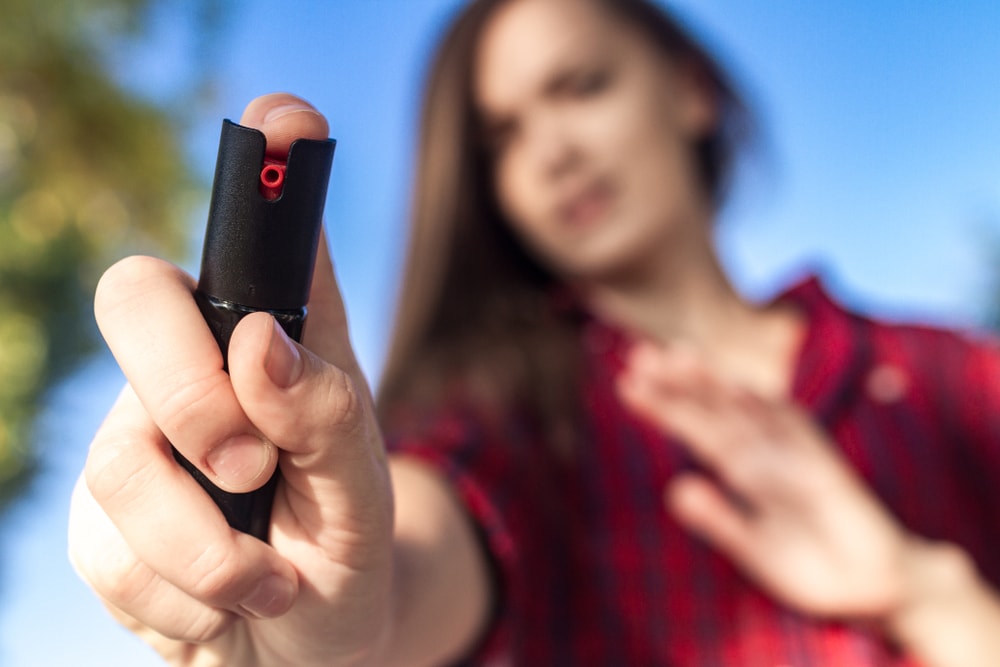
Pepper spray is an oil-based deterrent used by individuals for personal defense against humans. It’s considered a tool that individuals can use to temporarily stop a physical threat and allow the user to get away safely.
Pepper spray should only be used against individuals trying to inflict physical harm upon you. Other uses can be unlawful and may result in criminal or civil penalties for improper use.
Individuals can always keep pepper spray on their person in case they’re in physical danger from another person. Some people carry pepper spray when they’re walking or jogging out in public as a means of protection.
Effects of Pepper Spray
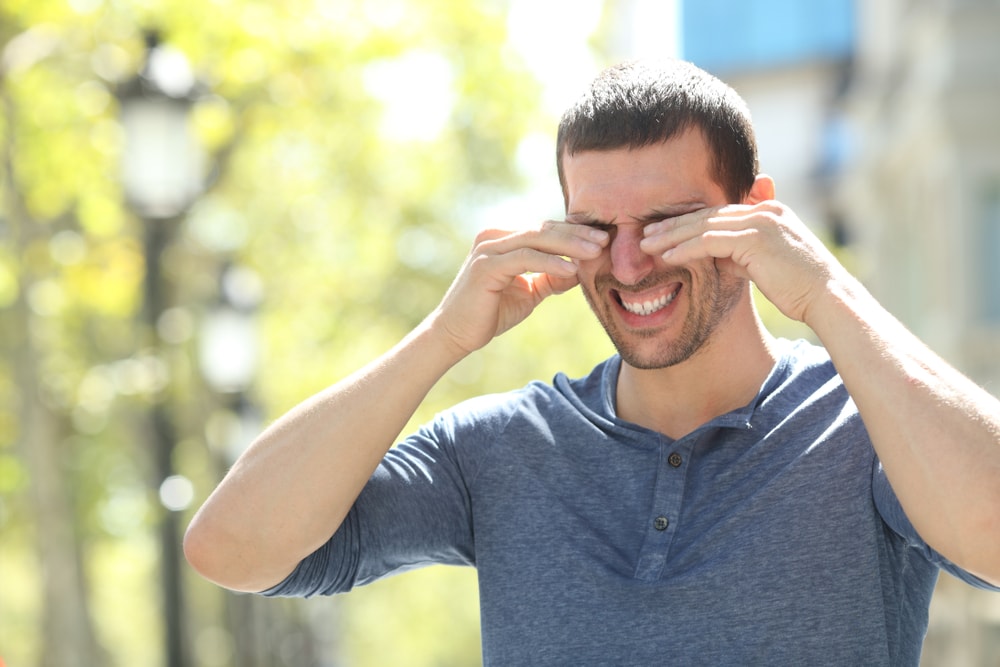
When an individual is sprayed with pepper spray, it usually causes the person to involuntarily close their eyes. Effects of pepper spray include burning eyes, face, and skin and difficulty breathing. It can temporarily disable a human.
Since everyone is different, the effects can be stronger for some individuals than others. People with a higher pain tolerance may not experience much of the effects.
The effects of pepper spray can last anywhere between 15-45 minutes. This can depend on the person who was sprayed and the type of spray the user has. The range of pepper spray can also differ depending on the specific spray. Some may have a spray range of about 10 ft (3 m).
The History of Pepper Spray
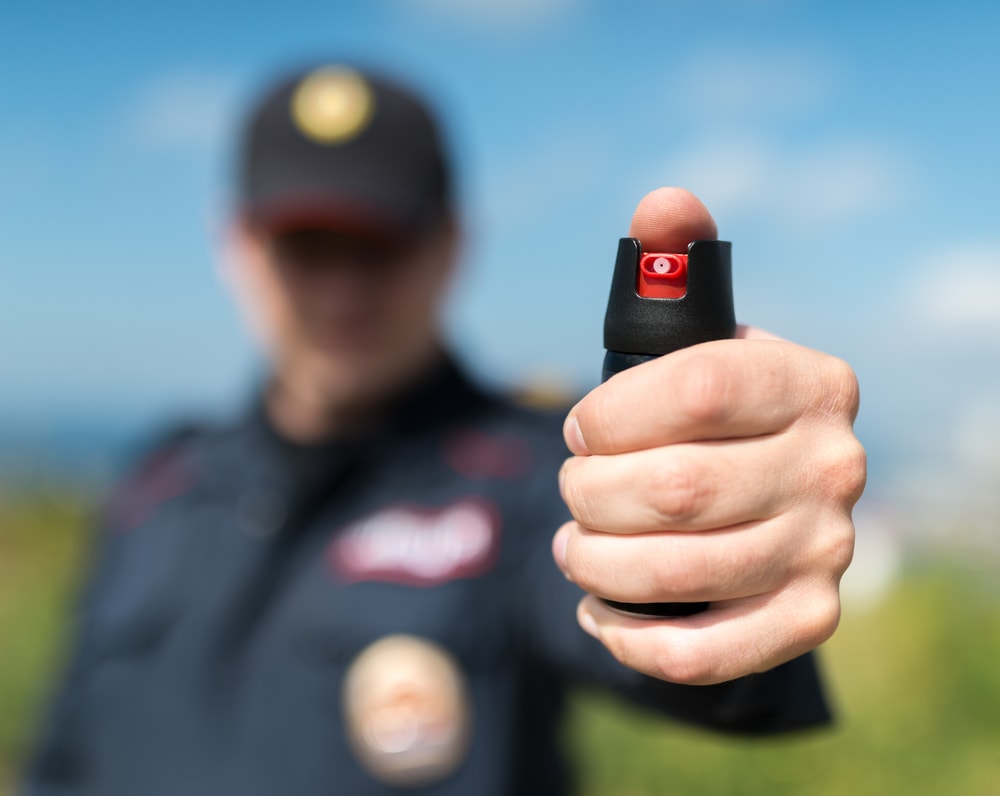
Pepper spray is a type of lacrimator that’s been used for different things throughout history. Other lacrimators include tear gas, which was used against enemies in World War I.
Tear gas included chlorine and mustard gas, which were considered chemical warfare agents. These types of gasses and other chemical warfare agents were banned by the 1925 Geneva Protocol. Pepper spray has also been used by law enforcement for crowd control.
Pepper spray used for personal defense dates back to the 1960s. It was often referred to as mace. This was the brand name for an early self-defense spray invented by Alan Lee Litman.
Mace included the active ingredient chloroacetophenone. Many pepper sprays today use other natural active ingredients that are oil-based.
You may also like: Ultimate Camping Checklist – Complete Guide To Everything You’ll Need + Printable PDF
How Does Bear Spray vs. Pepper Spray Work?
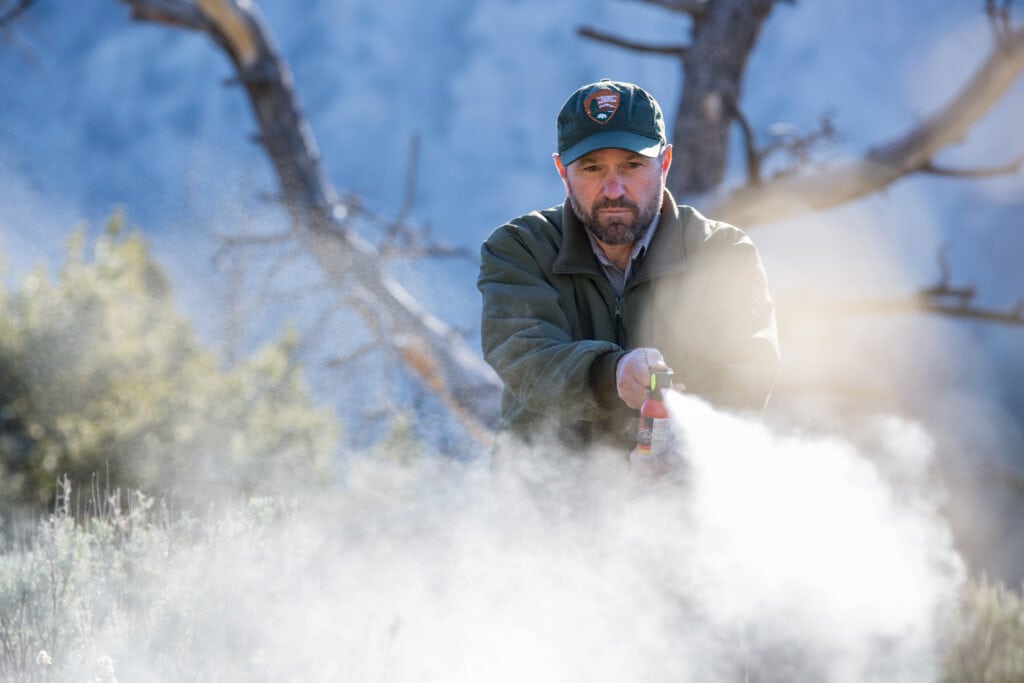
Bear spray and pepper spray are self-defense sprays made with the same active ingredient, oleoresin capsicum. This ingredient causes inflammatory effects that can temporarily disable a bear or human.
Individuals remove the safety clip and shoot the bear deterrent downward in front of a charging bear. Be sure to note the amount of time and range of the spray on the can.
Pepper spray should be held firmly in the palm of your dominant hand. You should use your thumb to disperse the spray at the attacker’s forehead. This allows the contents of the spray to drip down into the attacker’s eyes.
Bear spray is regulated by the US Environmental Protection Agency (EPA). Any spray that doesn’t meet EPA regulations isn’t considered bear spray, even if it’s advertised as so.
Pepper spray isn’t regulated by an agency like the EPA. Therefore, manufacturers don’t need to meet certain criteria for it to be labeled as pepper spray.
The concentration for bear spray must be between 1.4% to 1.8% of capsaicin and related capsaicinoids to be considered bear spray. The contents must derive from oleoresin capsicum, which should be at least 7.9 ounces (225 grams). The minimum range for bear spray must be at least 25 ft (7.6 m).

In states and countries where pepper spray is legal, the size and concentration of the spray may be controlled. This means that some states or countries may have to meet a size requirement for it to be legally carried.
The average range of pepper spray is typically around 10 ft (3 m). This range is ideal for users to keep a safe distance between themselves and the assailant.
You can make your own pepper spray at home. Since bear spray is regulated by the EPA, you can’t make it at home due to the criteria required for it to meet proper bear spray standards.
How to Make Pepper Spray at Home
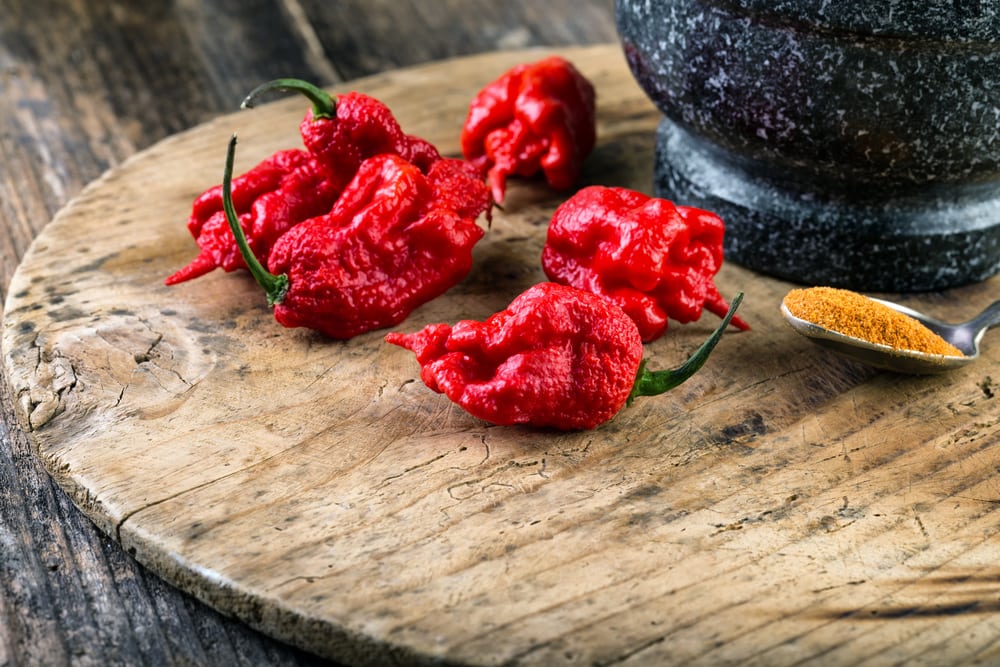
There are various recipes and instructions available for making pepper spray. However, safety is the most important aspect of making pepper spray at home. It’s also important to consider how effective homemade pepper spray can be compared to manufactured pepper spray.
Common ingredients used to make homemade pepper spray include:
- Pepper oil that has a high Scoville heat unit level
- Water, Acetum, or rubbing alcohol
Pepper oil or capsaicin is the active ingredient in pepper spray, which is essential for making it. It can be added to water, acetum, or rubbing alcohol. Acetum is vinegar. The heat of peppers is measured on the Scoville scale.
Peppers low on the scale aren’t as hot as peppers with a higher Scoville Heat Units (SHU) level.
For example, the Carolina reaper pepper is 1,500,000 to 2,200,000 SHU. It’s considered one of the world’s hottest peppers. A poblano pepper is significantly lower on the scale, with a SHU level of 1,000 to 2,000.
Making pepper spray from home can be dangerous. It needs to be handled properly, so the pepper oil doesn’t irritate your eyes, skin, or respiratory system. Safety goggles, rubber gloves, and a face mask are needed to protect you from the vapors created while making pepper spray.
Some recipes for pepper spray call for steeping peppers in the liquid you chose overnight. You can use a cheesecloth to drain the formula once it’s done steeping. You can use a spray bottle with a safety cap to put the liquid in.
You may also like: The Ultimate Guide To Winter Camping
What Are the Active Ingredients in Bear Spray vs. Pepper Spray?

The active ingredient in bear spray and pepper spray is oleoresin capsicum. This type of oil comes from plants of the family Solanaceae within the genus Capsicum. This includes pepper plants.
The oils in different pepper varieties include oleoresin capsicum. If you’ve ever cut peppers, got their residue on your hands, and then touched your eyes, you may have experienced the effects of this active ingredient.
The amount of oleoresin capsicum differs between pepper spray and bear spray. Pepper spray also isn’t regulated by an entity like bear spray. Therefore, the amount of oleoresin capsicum in pepper spray can vary depending on the specific spray you may have.
What Are the Differences Between Bear Spray and Pepper Spray?
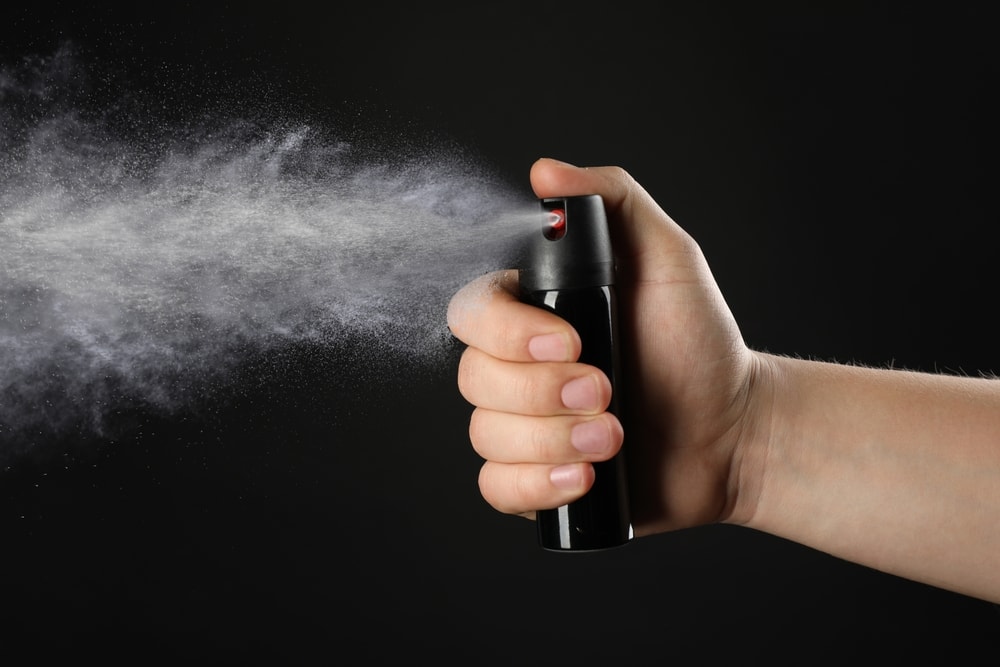
Many pepper spray brands may say that you can use pepper spray as a bear spray. However, some major differences between the two are important for their specific uses.
Some main differences between bear spray and pepper spray include the following:
Bear spray and pepper spray are designed differently because they serve different purposes. Pepper spray should only be used when you need to defend yourself against physical harm from a person. Bear spray should only be used against aggressive charging bears.
You may also like: 11 Coolest Types Of Tents
Pros and Cons of Bear Spray and Pepper Spray

Bear spray is considered highly effective against charging bears. However, it shouldn’t be treated as the only means to protect yourself. The pros of bear spray include the following:
You should always maintain awareness when out in nature, especially in bear country. Awareness and using caution may reduce the risk of encountering an aggressive bear.
Pepper spray is considered an effective tool for self-defense. It can temporarily disable an attacker from trying to cause you physical harm. Some pros of pepper spray include the following:
Like bear spray, individuals should be aware of their surroundings and not fully depend on pepper spray for self-defense.
Bear spray and pepper spray both have some cons. Bear spray only gives you a certain amount of time for the spray to disperse before it runs out. If not used at the proper distance, it could impact the effectiveness of the spray.
Some cons of pepper spray include:
If you purchase bear spray or pepper spray, it’s recommended to read the label and instructions of your specific spray. This can help you understand its range and how long it can disperse. Practicing can also help you get more comfortable using the spray so you’ll be ready in case you need it.
You may also like: How to Keep Mosquitoes Away While Camping
Bear Spray vs. Pepper Spray: Which is More Effective?

Bear spray and pepper spray are both effective for their specific uses. Bear spray is more effective against bears because of the higher concentration of active ingredients and the longer range it provides. It also has more liquid to disperse than typical pepper spray canisters.
It’s not recommended to use pepper spray as an alternative to bear spray. Bear spray shouldn’t be used on humans because it can have stronger effects that can cause harm to a human.
You may also like: Are Pandas Dangerous? Even The Gentlest Beast Can Bear Its Teeth
Conclusion
When to Use Bear Spray
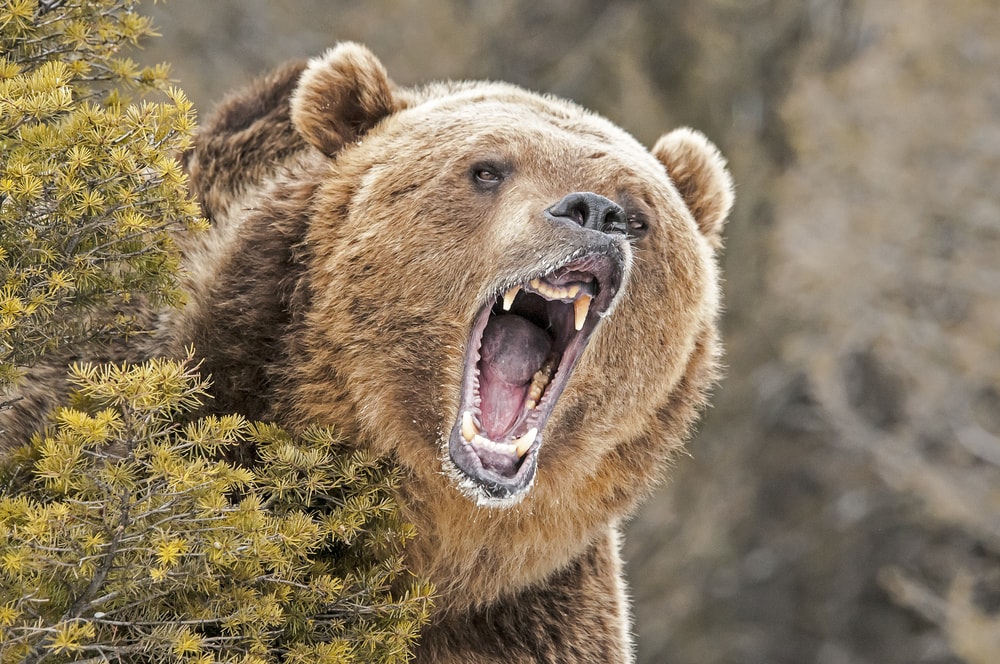
Bears can become aggressive toward humans for a number of reasons. Female bears are more likely to be aggressive when she has cubs with her. Here are some examples of when you should use bear spray:
- When an aggressive bear is charging at you
- When a bear is charging at you in the range the bear spray can disperse
It’s important to know what the range of your bear spray can is so you’re prepared to use your bear spray if necessary. Some sprays have a longer range than others. However, the minimum range requirement for all bear sprays is 25 ft (7.6 m).
When to Use Pepper Spray
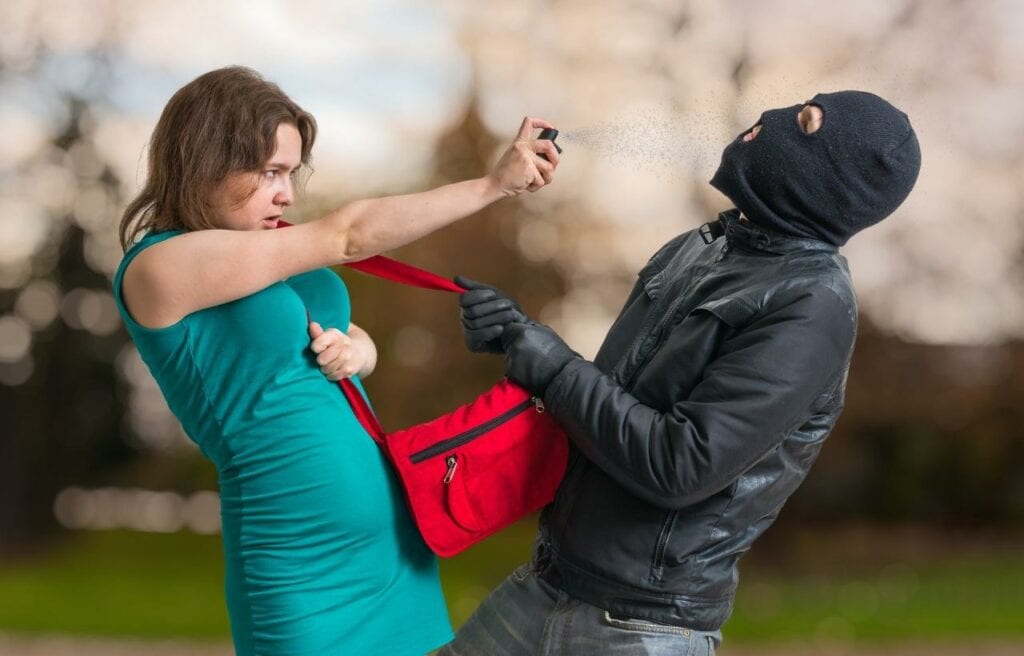
Pepper spray can be used for many situations requiring an individual to defend oneself. Some examples of when someone would use pepper spray may include:
- If someone is trying to cause you physical harm
- If a person isn’t affected by the first spray and is still trying to cause you harm
Pepper spray should only be used for self-defense situations when someone is attempting to physically harm you. Using pepper spray in any other situation may result in legal trouble.
You may also like: How Long Does Dry Ice Last? Handling & Storage Tips
Bear Spray vs Pepper Spray FAQs
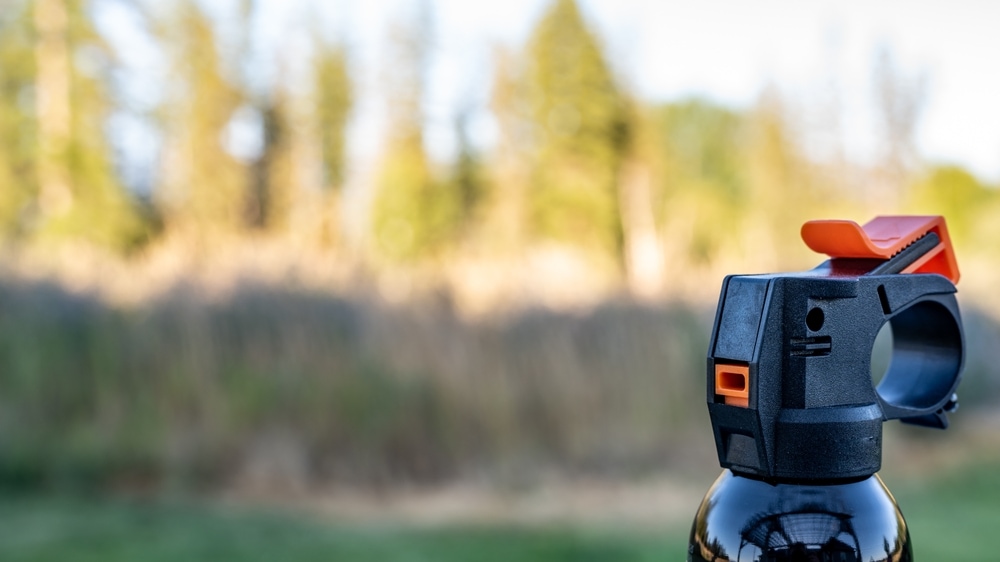
Which is better: bear horn or bear spray?
Bear spray is considered better for situations with an aggressive charging bear. Bear horns can be useful in deterring a bear that’s getting a little too close. However, it can also cause the bear to become more aggressive if it feels threatened by the loud horn.
You can keep a bear horn and bear spray on you in case you stumble across a bear, but bear spray is highly recommended in case a bear starts to charge you.
What can I use instead of bear spray or pepper spray?
Although bear spray is intended specifically for aggressive charging bears, other items may be used as an alternative in emergency situations. Wasp spray can be an alternative to bear spray if you don’t have any bear spray. Many wasp sprays have a long range, although not as long as bear spray.
Tasers are a self-defense weapon that can be used as an alternative to pepper spray. However, most tasers require users to get close to their attacker to be used.
Pepper spray isn’t recommended to use against bears because it may not be as effective. This could put you in a dangerous position if the pepper spray is unable to stop the bear from charging and may make it more aggressive.
Is it legal to use pepper spray against bears?
Certain states and countries may have specific laws relating to the use of pepper spray. Some countries may fully prohibit the use of pepper spray. It’s important to know the laws on pepper spray where you’re located.
In the United States, it’s legal to use pepper spray for self-defense in all 50 states. Improper use of the spray could result in criminal or civil penalties against the user.
Is it legal to use bear spray against people?
Bear spray shouldn’t be used against people. It can cause more severe effects on humans because it’s intended for bears. Using bear spray against a human, especially if it’s not in self-defense, could result in getting arrested or a lawsuit.









